Mathematical Insights into Tiling the Plane
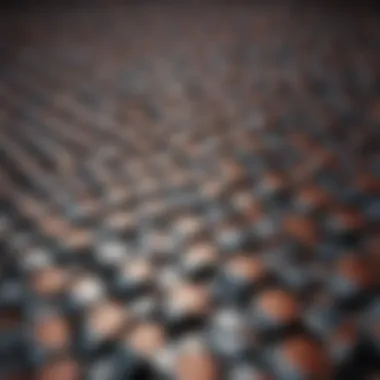
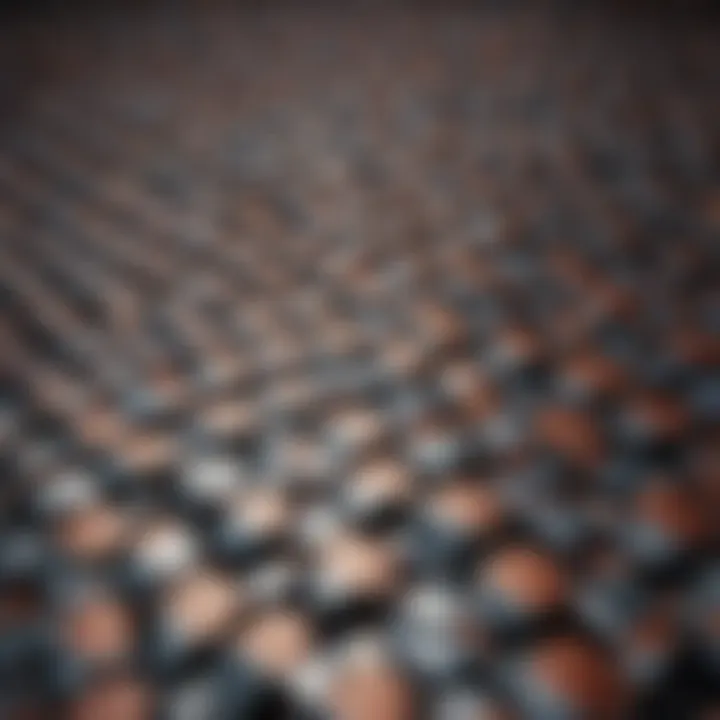
Intro
The idea of tiling the plane is more than just a mathematical curiosity; it’s a gateway to understanding complex relationships between shapes and patterns that appear across various domains. From the intricate designs found in Islamic art to the layout of tiles in our homes, the principles of tessellation weave through human creativity and scientific inquiry. The rich tapestry of history behind this concept challenges us to consider not only what is possible in mathematics, but also how it resonates with cultural expressions and real-world applications.
Venturing beyond mere aesthetics, this article seeks to illuminate the myriad methods and ramifications of plane tiling. It offers a bridge across disciplines, connecting elements of geometry with artistic practices, architecture, and even computational theory. As we embark on this exploration, it's essential to recognize that each tile placed—be it square, triangular, or hexagonal—recalls a fundamental truth about patterns and order in the chaos of our surroundings.
Prologue to Plane Tiling
Tiling the plane is a profound exploration into how complex surfaces can be partitioned into simpler shapes. This concept not only sits at the intersection of art and mathematics but also unveils patterns that resonate within various scientific fields. The significance of studying plane tiling cannot be understated; it provides insights into symmetry, geometry, and even the underlying order of nature. Moreover, understanding plane tiling enhances one’s ability to appreciate diverse aesthetic representations in mosaics, textiles, and digital designs.
Defining Tiling
Tiling involves covering a surface without overlaps or gaps. Imagine a checkerboard; each square is a tile, perfectly fitted together to cover a larger area. However, tiling goes beyond this simple example. It incorporates several geometric figures—squares, triangles, and hexagons—all of which serve as building blocks of the composition. The beauty of plane tiling lies in its ability to create intricate and harmonious patterns using seemingly elementary shapes. Essentially, when we define tiling, we are talking about the mathematically efficient arrangement of shapes that can fit a plane infinitely.
Tiling manifests in two primary forms: regular and irregular. Regular tiling involves the use of identical shapes, while irregular tiling introduces forms whose sizes and shapes vary yet still fit perfectly together. Key examples include.
- Regular Tiling: Figures such as squares or equilateral triangles that tessellate uniformly.
- Irregular Tiling: Unique patterns like Penrose tiling that don’t follow a repeated sequence, creating fascinating designs.
These basic definitions pave the way for broader applications and theoretical insights in the realm of mathematics, art, and even architecture.
Historical Context
The story of tiling is rich with cultural significance, dancing through the ages from ancient civilizations to modern-day practices. Historical evidence points to the use of tiling in ancient Egypt, where intricate mosaic floors adorned temples and tombs. This period saw the prominent use of geometric patterns, echoing a belief in symmetry and harmony in the universe.
As we leap through history, the Islamic Golden Age flourished with mathematical rigor, leaving a legacy of stunningly detailed tiling and mosaics. Islamic art has become synonymous with tiling, emphasizing geometric and floral patterns that evoke spirituality and infinity. This cultural approach to tiling has profoundly influenced Western art and helped integrate various mathematical concepts into artistic expression.
During the Renaissance, thinkers like Leonardo da Vinci explored tiling from a more mathematical perspective, marrying art with geometry and aesthetics. Tiling began to be recognized not just as an art form but as a field of mathematical inquiry. This recognition continued into the 20th century, as modern mathematicians and artists rediscovered the beauty in tessellations.
"Mathematics is the language in which God has written the universe." This idea captures the essence of how tiling represents more than mere decoration; it embodies a deeper understanding of the cosmos that appeals to mathematicians and artists alike.
Mathematical Underpinnings
The study of tiling the plane cannot be separated from its mathematical foundations. Understanding the mathematical underpinnings is crucial, as it lays the groundwork for both theoretical exploration and practical application. In this section, we delve into the geometry and topology that inform the diverse patterns and configurations that tessellation yields.
Geometry of Tessellations
Tessellations are fundamentally geometric in nature. They feature shapes that fit together without any gaps or overlaps, transforming a plane into a mosaic of organized patterns. A widespread example is that of the classic square tiling found in floor tiles. However, the beauty lies not only in regular shapes like squares and triangles but also in the intricacies that geometric principles explore. Here, one should consider these core elements:
- Regular Tessellations: These utilize one type of regular polygon, such as squares or equilateral triangles. The symmetry and balance of these shapes yield visually appealing designs.
- Semi-regular Tessellations: Combinations of different regular polygons create a more complex framework. Take for instance the well-known pattern of alternating hexagons and squares—this complexity opens a vast array of visual possibilities.
- Irregular Tessellations: These defy uniform shapes and utilize irregular forms. An example can be found in the study of art, where layers of randomness can generate unique visuals while still maintaining tiling principles.
When it comes to geometry, the angles and distances between the points of these shapes can provide insights into how many sides a tile has and how well it can cover a surface. The fascinating fact is that there are only a finite number of ways to tile a plane using regular polygons. Recognizing these constraints helps demystify the patterns that emerge when different geometrical shapes combine.
Topology and Tiling
Topology, often described as a branch of mathematics that studies the properties of space, plays an important role in the realm of tiling. This field considers spaces and their transformations without regard to their actual shape. The most common application here pertains to understanding how these tiled spaces can stretch, shrink, or twist without tearing or gluing them together.
In tiling, we encounter various topological configurations that change properties without altering their fundamental characteristics. For example, envision a toroidal surface—a donut-shaped form—where tiles can be arranged in a manner distinct from a flat plane. This extension of concepts allows mathematicians to explore tiling not just in classical forms but also in higher dimensions, leading to unique results in mathematical art and design.
Consider these essential topological considerations in tiling:
- Connectedness: Tiles must be laid out in a connected manner to form a coherent pattern. If a tile "breaks away," the pattern loses its integrity.
- Compactness: This concept dictates that at any point in a configuration, a section can be entirely contained within the larger space without leaving any gaps.
- Homeomorphism: A fascinating idea in topology, this term describes how a space can be stretched or deformed into another without cutting. It encourages a vast understanding of relationships among tiling forms across varied dimensions.
By analyzing the geometry and topology of tiling, we gain insight into not only the rigid structures of mathematical theory but also the fluidity and creativity inherent in this domain. Tiling transcends the mere act of covering a plane. It evokes a sense of unity within mathematics, art, and science, merging them in a dance that both captivates and challenges the limits of our imagination.
"Mathematics, and particularly the study of tiling, reveals the exquisite harmony between form and function, grounding abstract theories in tangible beauty."
Through these mathematical lenses, we can appreciate the significance of tiling as it relates to practical usage in various fields while fostering an environment of creativity and exploration.
Types of Tiling
Tiling the plane isn't just about filling space; it's an exploration of patterns, structure, and the creativity of mathematics. The different types of tiling showcase geometric principles that have significant applications across various fields, from art to computer science. Understanding these types helps in grasping both the aesthetic and practical aspects of tessellation. They highlight how geometric arrangements can create visually appealing designs, optimize space, and even influence modern architecture. With this in mind, let’s dive into the two main categories of tiling: regular and irregular.
Regular Tiling
Square Tiling
Square tiling is perhaps the most recognizable form of tessellation. Its simplicity and uniformity make it an excellent choice for various applications, from flooring to building facades. A key characteristic of square tiling is its ability to fill a plane completely without gaps or overlaps.
- Benefits: One of the major advantages of square tiling is its ease of arrangement. Each square can be laid down in numerous configurations, allowing for creative designs while maintaining structural integrity.
- Unique Feature: The uniform sides of square tiles also enable simple calculations when estimating the number of tiles needed for a project.
While it is straightforward, square tiling could be seen as somewhat monotonous if not complemented with color or texture. Too much use of identical square tiles in a design may lead to predictability.
Equilateral Triangle Tiling
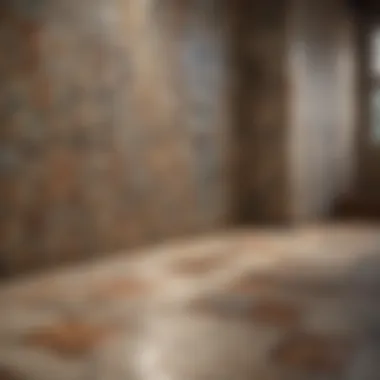
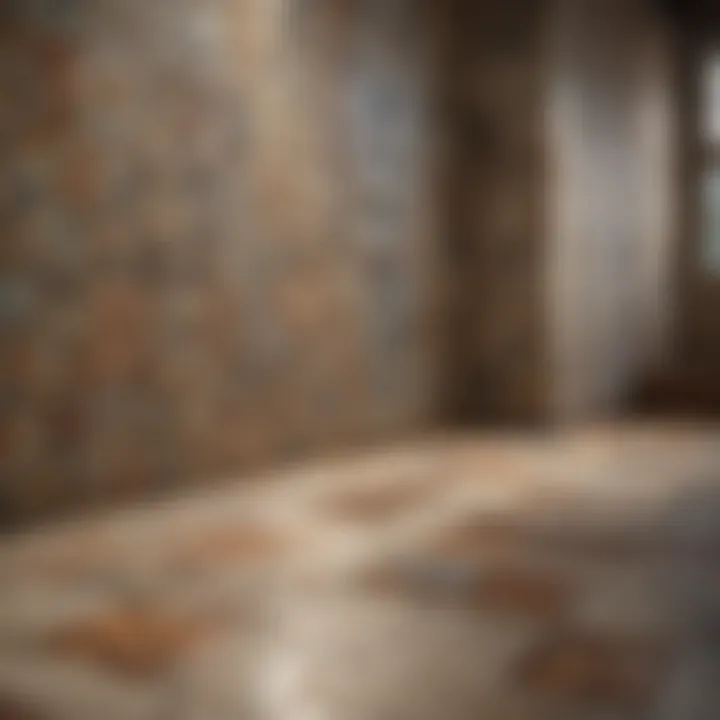
Equilateral triangle tiling introduces a different aesthetic element into the tiling world. These triangles, all having equal sides and angles, seamlessly fit together. This method allows for dynamic patterns that can evoke a sense of movement and flow.
- Benefits: A significant advantage of equilateral triangle tiling is the versatility in creating complex patterns without needing larger tiles. It can produce intricate designs that capture attention without overwhelming the space.
- Unique Feature: Unlike squares, the angles of equilateral triangles can be rotated, creating an engaging play with orientation.
However, the arrangement can become tricky when scaling designs, as ensuring symmetry requires careful planning.
Hexagonal Tiling
Hexagonal tiling takes a more organic approach to space filling. With each hexagon having six equal sides, this form can touch more neighbors than either squares or triangles, which often creates a more densely packed layout.
- Benefits: This type of tiling is incredibly efficient for covering large areas, using fewer edges and materials than regular square layouts. Hexagonal grids can be seen in nature, such as in bees' honeycombs, which emphasizes their efficiency.
- Unique Feature: Hexagonal patterns also offer unique visual effects, creating a sense of depth and curvature that other forms may lack.
However, designing a space with hexagons can become complicated because of the need to manage how tiles interact at edges. It requires careful consideration of adjacent shapes.
Irregular Tiling
Penrose Tiling
Penrose tiling stands out as an example of irregular tiling that defies conventional rules. This non-periodic tiling means that it never completely repeats itself. The quasiperiodic nature of Penrose tiles creates unique and captivating patterns.
- Benefits: One of its significant contributions is in the realm of aperiodic order, where it challenges the very concept of repetition in design. This complexity leads to visually stunning art and can even be a conversation starter.
- Unique Feature: The use of two tile types (usually shaped like kites and darts) produces an infinite variety of patterns without ever repeating.
Despite its beautiful designs, Penrose tiling can be challenging to implement in practical projects, as the randomness can lead to confusion in execution.
Voronoi Diagrams
Voronoi diagrams utilize a different approach to irregular tiling by dividing a plane into regions based on distance to a specified set of points. Each cell contains a point that is closer to it than to any other point. This method has important implications in fields like biology and urban planning.
- Benefits: Voronoi diagrams can greatly influence how we understand natural patterns, such as cell arrangement in biology or optimizing resource distribution in urban areas.
- Unique Feature: The irregularity found within Voronoi patterns allows for natural and organic designs that mimic real-world objects or landscapes.
However, creating Voronoi diagrams can require more computational effort, especially in data-heavy contexts. The complexity may lead to challenges in precise implementations.
Mathematical Properties
The study of mathematical properties in the context of tiling is fundamental in understanding how patterns come about and the intrinsic characteristics that govern them. These properties reveal not just the aesthetic appeal of tilings, but also their underlying structures and relevance in various mathematical fields. Analyzing the mathematical properties behind tiling enhances our appreciation of symmetry, periodicity, and spatial organization, offering a glimpse into how geometry and mathematics intermingle in a visually compelling manner. Therefore, grasping these concepts can significantly benefit students and researchers seeking to deepen their knowledge of this rich tapestry of mathematics.
Symmetry in Tiling
Symmetry serves as a cornerstone in the understanding of tiling patterns. It refers to the balanced proportions and harmonious arrangement found within a given tiling system. When discussing symmetry, one can consider reflections, rotations, and translations as the primary operations. Each of these transformations can produce new arrangements that still conform to the original tiling rules.
Symmetric tilings can fall into several categories, including:
- Reflective Symmetry: When a tiling can be divided into mirror-image halves. For instance, consider a checkerboard pattern; flipping one half over creates a perfect match with the other half.
- Rotational Symmetry: This occurs when a pattern can be rotated around a central point and still appear the same. A classic example is the hexagonal tiling, where a twist by 60 degrees reveals an identical configuration.
- Translational Symmetry: This allows patterns to repeat in regular intervals across a plane. Think of wallpaper designs that seem endless; no matter how far you travel in one direction, the pattern continues seamlessly.
Understanding symmetry is crucial because it simplifies many problems in tiling theory, influencing calculations and predictions about how tiles can be arranged.
Filling the Plane
Filling the plane refers to the process by which a plane is completely covered without any gaps or overlaps. This concept not only embodies the practical aspect of tiling but also serves as a foundation for exploring various types of arrangements in both mathematical and applied contexts.
To fill a plane effectively, one might consider:
- Regular Tessellations: These are achieved using one type of regular polygon, such as squares, triangles, or hexagons. Each shape can tile the entire plane seamlessly.
- Semi-Regular Tessellations: Here, two or more different polygon types are utilized, offering more complex arrangements. For instance, the combination of squares and octagons creates an interesting visual while still filling the space efficiently.
- Aperiodic Tiling: Unique in its own right, aperiodic patterns do not repeat themselves. Penrose tiling is a well-known example, creating intriguing patterns that challenge our traditional notions of filling the plane without repetition.
The methods used to effectively fill the plane with a variety of shapes are valuable not only in pure mathematics but also in computer graphics, architecture, and design. Being able to visualize and simulate various filling techniques opens up new avenues for creativity and implements mathematical understanding into real-world applications.
"Tiling is more than just a mathematical curiosity; it's a celebration of balance, structure, and creativity, manifesting in numerous forms across different domains."
By examining mathematical properties related to symmetry and filling the plane, one gains insights that transcend simple tiling rules, revealing deeper connections to geometry, topology, and even artistry. In essence, these properties serve as a bridge linking abstract mathematics to tangible outcomes in artistic endeavors and practical applications alike.
Applications of Tiling
Tiling, a mathematical marvel, breathes life into both art and science. Its applications are found everywhere, from ancient structures to the latest digital designs. Understanding these applications helps us appreciate the cultural significance and practical utility of tiling. This section will discuss how tiling plays a pivotal role across various domains.
In Art and Architecture
Art and architecture are fields where tiling takes center stage. Its ability to transform spaces and convey ideas is unmatched.
Mosaics
Mosaics represent a fascinating intersection of art and structure. Comprised of small, colorful pieces, they create stunning visual narratives. One key characteristic of mosaics is their versatility; they can adorn everything from floors to walls, bringing vibrancy to public spaces. This feature makes mosaics a popular choice in this article as they exemplify how tiling transcends mere aesthetics, often telling stories of cultures and histories through their patterns.
However, creating mosaics can be labor-intensive. Precision is crucial, and mistakes can mar the overall effect, which may discourage some artists. Yet, their enduring nature and historical significance contribute positively to their appreciation and value.
Islamic Art
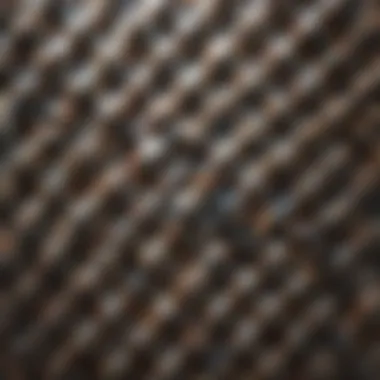
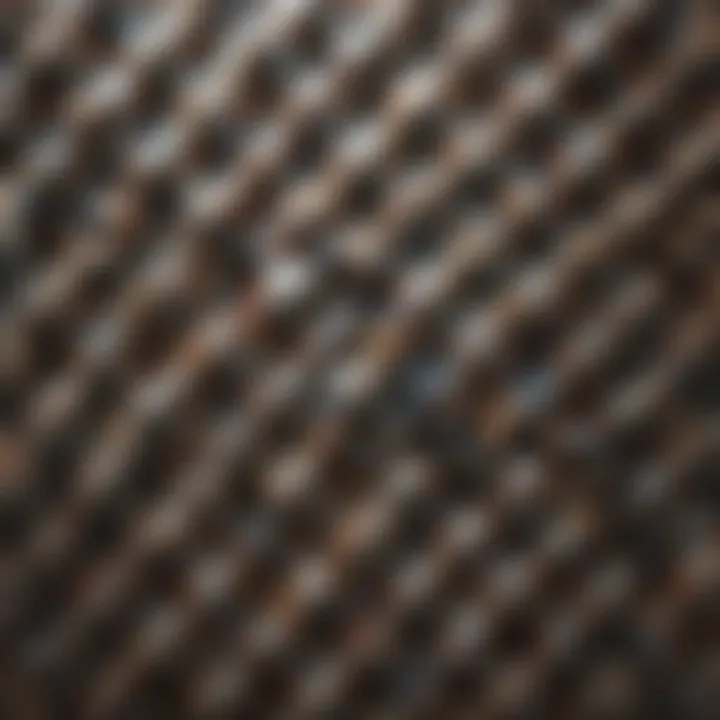
Islamic art is another domain where tiling shines brightly. Geometric patterns dominate this form, with intricate designs serving both ornamental and spiritual purposes. A key characteristic of Islamic art is its emphasis on symmetry and repetition. This focus makes it particularly relevant for this article, as it delves into how mathematical principles guide creativity. The unique feature of Islamic tiles is their ability to reflect light and create dynamic visual experiences in sacred spaces.
Its disadvantage, however, lies in its cultural specificity. Those unfamiliar with these patterns might find them challenging to interpret, leading to potential misinterpretation of their meanings and importance.
Modern Design
In modern times, design trends often leverage tiling to create functional yet appealing environments. The clean lines and geometric arrangements have a broad appeal, making them a staple in contemporary architecture. One outstanding aspect of modern design is its efficiency in space utilization. This creates a utilitarian aspect that benefits this article's exploration of practicality in tiling applications.
However, while modern tiling embraces minimalism, it can sometimes appear stark or cold, lacking the warmth of traditional designs. This duality shows that while modern approaches can be sleek and sophisticated, they also warrant consideration of emotional resonance.
In Science and Nature
Science and nature showcase tiling's foundational role in contributing to our understanding of structures and processes.
Crystallography
Crystallography relies heavily on tiling principles to understand molecular structures. The precise arrangements of atoms create tessellations at a microscopic level. This aspect is critically important here, as it illustrates how geometry is not just an artistic concept but a fundamental science. A unique feature of crystallography is its ability to showcase symmetry and repeated patterns, essential for identifying the properties of various substances.
Yet, studies in crystallography can sometimes be highly specialized, posing a challenge to broader comprehension. The complexity of these patterns might alienate those outside the field, but their implications are vast, affecting everything from materials science to pharmaceuticals.
Biological Structures
Nature also utilizes tiling in a variety of biological structures. The arrangement of cells, leaves, or even animal fur often adheres to tiling principles to ensure efficiency and beauty. For example, the hexagonal arrangement found in honeycombs is particularly striking. A critical characteristic of biological structures is the optimization of space – they use minimal resources while maximizing functionality. This facet contributes greatly to the understanding of evolutionary designs.
However, representing biological structures with rigid tile patterns may overlook the fluidity and variability often seen in nature. This aspect invites further exploration and research, reflecting the ongoing evolution of our comprehension of tiling principles.
In summary, the applications of tiling in both art and science not only demonstrate its aesthetic appeal but also its functional relevance. Such duality emphasizes the profound effects of geometry in our world.
Algorithms and Computational Tiling
The process of tiling a plane extends beyond just a geometric exercise; it delves deeply into the realm of algorithms and computational approaches. These elements serve as the backbone of our ability to generate complex tiling patterns with precision. In this section, we’ll take a closer look at how computational methods enhance our understanding and application of tiling techniques.
Algorithms in tiling can be viewed as step-by-step procedures or formulas that ensure the systematic arrangement of shapes on a plane. The necessity for these algorithms arises when dealing with intricate patterns or when automation is preferred—think of scenarios in video games, architectural design, or digital graphic art where time and accuracy are critical.
An essential aspect of algorithms in the context of tiling is their ability to handle vast amounts of data efficiently. Unlike manual methods, which can be prone to errors and require considerable effort, algorithms can quickly compute and display tiling patterns that might otherwise be too complex for human hands. The exploration of these algorithms provides insights into both their practical applications and their theoretical implications.
Generating Tiling Patterns
Generating tiling patterns involves the use of various algorithms tailored specifically for this purpose. The process can range from simple iterative methods to more advanced techniques employing mathematical concepts.
- Algorithms like the Subdivision Method: This technique starts with a basic shape and progressively divides it into smaller regions, ensuring the overall tiling remains cohesive. The beauty lies not only in the final product but also in the exploration of the intermediate stages.
- Recursive Algorithms: These leverage the principle of breaking a problem down into smaller instances of the same type. When applied to tiling, they can produce intricate designs, often with surprising results that reflect fractal properties, where a pattern repeats on various scales.
- Geometric Transformation: This approach utilizes transformations such as rotation, reflection, and translation. By manipulating tiles through these transformations, one can generate a multitude of patterns from a single shape – turning the mundane into the spectacular.
Generating these patterns can also be achieved through software like Processing or MatLab, which provide interactive environments conducive to visual experimentation. An open-source alternative is Tiling Lab, where enthusiasts can play with different algorithms and see the immediate results of their adjustments.
Tile-Based Game Development
In the realm of game development, tile-based systems are fundamental for constructing levels and environments. Tiles serve as modular building blocks, enabling developers to create vast worlds without overloading game performance. This efficiency in game design can be traced back to two significant aspects:
- Spatial Organization: With tiles, developers can easily manage the layout of game environments. The grid-like nature allows for predictable movement and interaction, fostering intuitive gameplay mechanics.
- Resource Management: Using tiles helps developers save on computational resources. Instead of rendering unique graphics for every surface or environment, tiles can be repeated and combined in diverse ways, thus minimizing the memory footprint.
Tile-based games, such as Tetris or Stardew Valley, showcase how effective these algorithms are, enabling a user experience that's seamless and engaging. Moreover, the beauty of employing algorithms in game design is that they pave the way for procedural generation, giving rise to unique experiences each time a player engages with the game.
"Computational tiling not only shapes our digital landscapes but also our understanding of space and structure in ways we are only beginning to explore."
As we continue to push the boundaries of technology and mathematics, algorithms and their applications in tiling are set to revolutionize fields not just in gaming and architecture, but in scientific visualization and beyond.
Cognitive Perspectives on Tiling
When exploring the concept of tiling, it's essential to consider how human cognition interacts with patterns and shapes. Tiling isn’t just a mathematical endeavor; it’s deeply rooted in the way we perceive and interpret the world around us. Understanding the cognitive perspectives on tiling sheds light on both the psychological implications of pattern recognition and the cultural significance embedded within these designs.
Cognitive studies suggest that our ability to recognize patterns, such as those found in tiling, is a fundamental aspect of human thought. This capability is not merely a visual practice; it goes beyond that, influencing how we process information, experience art, and even solve complex problems. Tiling serves as a bridge between abstract mathematics and tangible perception, creating a unique intersection where cognition and art meet.
Benefits of Understanding Cognitive Perspectives:
- Enhances appreciation of patterns in everyday life.
- Informs educational approaches, particularly in teaching geometry and spatial reasoning.
- Encourages interdisciplinary connections between mathematics, psychology, and art.
This exploration can not only provide insights into individual thought processes but also into collective cultural expressions, shaping community identities through shared aesthetic experiences.
Psychological Aspects of Patterns
The psychological aspect of pattern recognition emphasizes how individuals identify, categorize, and assign meaning to visual stimuli. Patterns in tiling consist of a variety of shapes that repeat or interlock in specific ways. Our brains seem to be hardwired to recognize these connections, pulling from our experiences with symmetry and order.
Researchers have noted a phenomenon known as the "Gestalt Principles of Organization," which speaks to how our minds seek out patterns in seemingly chaotic arrangements. These principles, such as proximity, similarity, and closure, help elucidate why certain tiling designs appeal more to our senses than others. For instance, a large mosaic might evoke certain emotions through its repetitions and color harmonies that our brains quickly decode—bridging the gap between chaos and order.
In a classroom or an artistic setting, leveraging these insights can lead to deeper engagement with both the subject and the methods used to convey these concepts. By utilizing tiling as a visual and practical tool, educators can create stimulating environments that promote creativity and problem-solving skills.

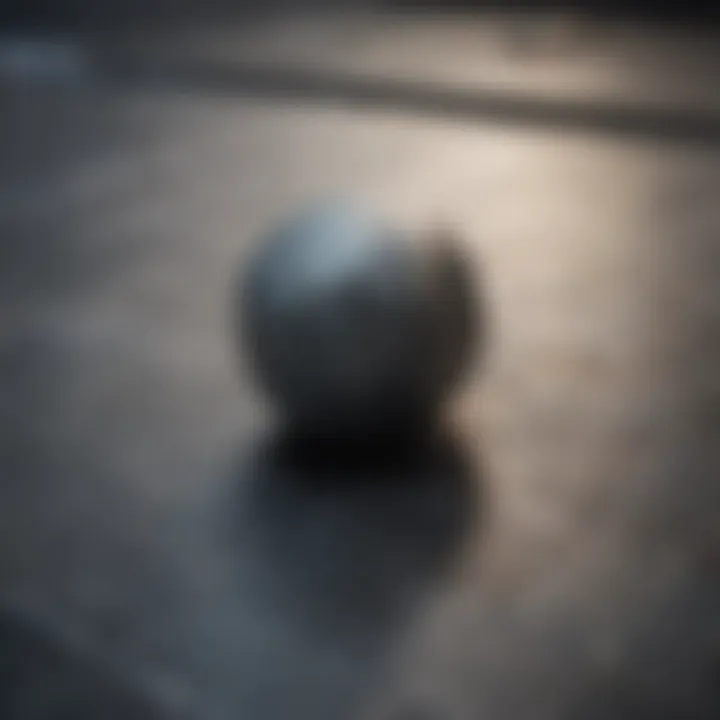
Cultural Significance of Tiling
Beyond psychological perceptions, tiling embodies significant cultural narratives across different societies. In many cultures, tiling patterns represent geographic origins, convey spiritual beliefs, or signify communal values. For example, intricate patterns found in Islamic art surpass mere decoration; they reflect a philosophy surrounding infinity and the divine.
Tile work in various forms can be identified as identity markers, showcasing everything from regional characteristics to historical influences. These unique designs often vary dramatically from one culture to another, influenced by available materials and prevailing artisanship techniques. Thus, examining the diverse applications of tiles across cultures not only promotes a deeper understanding of aesthetics but also fosters appreciation for multicultural dialogue.
Tiling acts as a canvas upon which identity, belief, and history intertwine, encapsulating the essence of a culture.
In summary, cognitive perspectives on tiling not only enhance our interaction with the visual world but also reveal profound insights into cultural expressions. Tiling emerges as more than just an aesthetic marvel; it reflects complex cognitive processes and deep-seated cultural values.
Experimental Approaches to Tiling
The exploration of experimental approaches to tiling introduces a hands-on perspective that enriches the understanding of the mathematical and artistic facets of tessellation. By engaging with physical materials and digital platforms, learners can observe the principles of tiling in action. This section emphasizes the necessity of these experimental methods, as they facilitate an experiential learning process that theoretical study alone cannot provide. Through interaction with tangible and virtual tiles, students, researchers, and educators can witness the effects of different geometric configurations firsthand, fostering a deeper grasp of the subject.
“Mathematics isn’t a strict chain of rules; it’s more like a dance where you can feel the rhythm of the patterns.”
Hands-On Activities
Participating in hands-on activities allows individuals to directly engage with the principles of tiling. Here are a few exciting methods:
- Physical Tile Arrangement: Using square, triangular, or hexagonal tiles, individuals can explore how these shapes fit together. This exercise illustrates concepts like edge matching and symmetry. A simple example might involve constructing a basic mosaic using colorful ceramic tiles to create an intricate pattern, lending a tactile dimension to abstract geometric theories.
- Paper Folding: Origami can serve as an engaging method for experimenting with tiling. By folding paper into various geometric shapes, one can visualize and physically manipulate how these shapes can tessellate. This art extends beyond mere aesthetics, allowing for explorations of symmetry and plane coverage.
- Creating Custom Patterns: Participants can draw their own shapes and test how they fit within a defined area. It sparks creative thinking and reinforces the concept that not all tiles must be regular or predictable. This versatility is crucial in both mathematical and real-world applications of tiling.
Digital Simulations
Digital simulations have transformed the landscape of tiling experiments, enabling users to visualize and manipulate complex tessellations that would be nearly impossible to achieve with physical materials. Here are some key elements:
- Tiling Software: Programs such as Tesselmaniac, or online tools like GeoGebra, allow users to design and simulate intricate patterns easily. Through these platforms, they can test the limits of different tiling types, analyzing properties like symmetry and repetition.
- Interactive Models: Virtual reality (VR) environments can offer immersive experiences where users manipulate tiles in 3D space. By rotating and rearranging virtual tiles, one can grasp how shapes interlock within a plane more effectively than in traditional two-dimensional settings.
- Algorithmic Approaches: Using coding languages like Python or JavaScript, aspiring coders can create programs to generate tiling patterns algorithmically. This type of project not only enhances understanding of mathematical concepts but also equips users with valuable programming skills.
Challenges in Tiling Theory
Tiling theory is a vibrant area of study that merges mathematics, art, and logic. However, it does not come without its set of challenges. These challenges bridge artistic considerations with mathematical rigors and present unique learning opportunities. Addressing the difficulties in tiling can enhance our understanding and appreciation of the field—both in theoretical frameworks and practical applications.
One key challenge relates to the balance between aesthetics and mathematical validity. Artists often bend or even break the traditional rules of tessellation to create visually appealing patterns. This push against convention does not simply involve superficial changes; it can lead to significantly new findings in the underlying mathematics of tiling. The conversation shifts from strict adherence to rules to exploring how these rules can be modified or expanded.
Furthermore, the complexity of irregular tiling patterns, such as those found in Penrose tiling, adds layers of difficulty. Understanding how a shape can tessellate without repeating across the entire plane raises intriguing questions about predictability and chaos in mathematics. Concepts like these challenge our established notions of symmetry and regularity, compelling us to rethink what constitutes a valid tiling strategy.
Lastly, embracing these challenges illuminates potential avenues for future exploration, making it crucial for researchers and enthusiasts alike to push the envelope of what is considered possible in tiling.
Breaking Conventional Rules
In the world of mathematics, adhering to established norms is often seen as the gold standard for ensuring correctness and clarity. Yet, when it comes to tiling, breaking conventional rules can be a catalyst for innovation. Tiling patterns that deviate from traditional symmetry can offer new perspectives—both aesthetically and mathematically.
Evident in artists like Escher and contemporary designers, this nonconformity often leads to unexpected insights. For instance, consider a hexagonal tiling pattern where tiles have irregular shapes or interspersed gaps. Such deviations may at first seem chaotic; however, they demand a reconsideration of underlying geometrical principles while inspiring creativity.
Adopting a more fluid approach to rules also opens the door for interdisciplinary dialogue. Artists collaborating with mathematicians can discover patterns that might remain hidden in purely mathematical examinations. For example, loose rules around symmetry can yield designs that maintain visual harmony while introducing asymmetry—challenging the audience's perception and understanding of space.
Open Problems in Tiling Research
Research in tiling often grapples with unresolved questions that can seem daunting. Some of these open problems invite both amateur and seasoned mathematicians to contribute their insights. One prominent issue is the nature of aperiodic tiling and the exploration of its properties. The existence of tiles that can cover a plane without repeating patterns, such as those found in Penrose tiling, is a compelling area of inquiry.
Another interesting avenue is related to the computational aspect of tiling. How do we determine the most efficient way to cover a given area with various shapes? The complexity involved in different shapes, their orientations, and the interactions between adjacent shapes opens a Pandora's box of combinatorial challenges. Researchers often find themselves at a crossroads between theoretical exploration and practical implementation in algorithm design.
Furthermore, there's a growing body of work surrounding the applications of tiling theory in understanding complex systems, both in science and nature. Areas like material science and biology can benefit from the principles of tiling. For example, how do proteins fold? Exploring these open questions in relation to tiling theories might lead to breakthroughs not just mathematically, but in real-world applications.
"Tiling is where creativity meets mathematics. Each shape has a story, and if we let go of conventions, we open a door to endless possibilities."
In summary, while challenges abound in tiling theory, they foster a culture of inquiry that drives mathematical and artistic boundaries. By examining the threads of conventionality and exploring open questions, we not only enhance our knowledge but also our creativity in the dynamic landscape of tiling.
Epilogue and Future Directions
The exploration of plane tiling not only enriches one’s understanding of mathematical concepts but also prompts a broader appreciation for its myriad applications. The discussion around the tiles—whether they are squares, triangles, or intricate Penrose shapes—offers a lens into both theoretical and practical aspects of the discipline. Every facet of this investigation highlights how essential the fundamental principles of tiling can be in diverse fields such as art, architecture, and even natural sciences.
In summarizing the insights gained throughout this article, one must consider the flexibility of tiling approaches, how they serve as a bridge between geometry and topology, and the unique properties inherent to each arrangement. The simple act of covering a plane can lead to complex interactions and stunning visuals that resonate across various domains of study.
Summarizing Key Insights
To distill the richness of this discourse into digestible components, here are several key insights:
- Diversity of Tiling Types: Regular and irregular tiling showcases vast possibilities, revealing how creativity and structure can coexist.
- Mathematical Foundations: The ties between symmetry, geometry, and topology are pivotal, as they enable the understanding and classification of different tiling designs.
- Applications Across Fields: The utility of plane tiling transcends mere mathematics, finding relevance in art motifs, biological patterns, and even theoretical physics.
As we contemplate the future directions of this vibrant field, it becomes apparent that new technologies, particularly computational tools, can further our understanding of existing theories while propelling the exploration of new concepts. This means researchers are encouraged to think outside boxes—literally and metaphorically—and venture into uncharted territories of tiling intricacies.
The Future of Tiling Research
Moving forward, the future of tiling research is poised to be fascinating. Here are some areas for future exploration:
- Interdisciplinary Collaboration: Increased collaboration among mathematicians, artists, and architects may lead to innovative approaches that challenge the status quo of traditional tessellation designs.
- Algorithmic Development: Enhancements in algorithm creation for generating complex tile patterns have the potential to revolutionize how we visualize and comprehend tiling.
- Explorations in Non-Euclidean Spaces: Researchers might also explore tiling in non-Euclidean geometries, which can yield entirely different types of tessellations and mathematical properties.
"The beauty of tiling is that it mirrors reality in form and function, linking the abstract to the tangible."
By embracing these possibilities, scholars can further decode the intricate language of tile configurations, deepening our understanding of their implications across various mathematical and practical landscapes. The journey of exploring the concept of plane tiling is just beginning, making the anticipation for what lies ahead equally exciting as the discoveries made so far.















